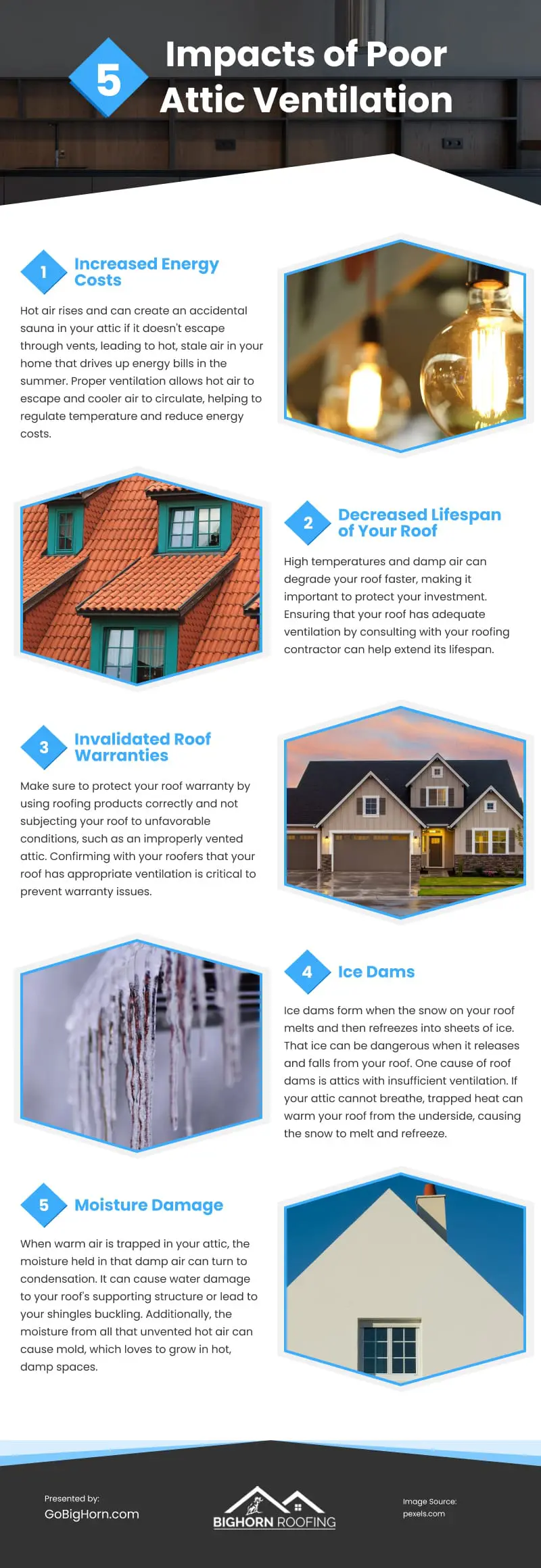
In this infographic, we delve into the critical topic of attic ventilation and its profound impact on homes. Proper ventilation is a cornerstone of a healthy living space. This infographic explores five critical consequences of poor attic ventilation, ranging from escalated energy costs to potential structural damage.
1. Increased Energy Costs
Hot air naturally rises, and when confined to an inadequately vented attic, it transforms your home into an unintentional sauna. That leaves your house full of hot, stale air. That will drive up your energy bills, particularly in summer when you are fighting the heat and relying on the natural cooling effect that comes from your house, breathing out the hot air and breathing in the cooler air. When your attic isn’t well-vented, your home can’t breathe, leading to suffocatingly high energy bills.
2. Decreased Lifespan of Your Roof
Excessive heat and moisture are formidable adversaries to your roof. Prolonged exposure to these elements can accelerate the deterioration of roofing materials. Since a new roof is a significant investment, you want to do what you can to make sure you are protecting it. That means confirming with your roofing contractor that you have all the necessary vents, which will extend the lifespan of your roof.
3. Invalidated Roof Warranties
Warranties accompany most roofing products, but they are contingent on proper usage conditions. You may void your warranty if you ask your roof to do something outside the expected conditions. That includes forcing your roof to operate over an improperly vented attic. This is another reason it is critical to confirm with your roofers that your newly installed roof has the appropriate ventilation. Protect that warranty, and your roof, by ensuring you aren’t creating conditions unfavorable to your roof and contrary to your warranty.
4. Ice Dams
Ice dams, formed when snow melts and refreezes, pose safety and structural threats. Inadequate attic ventilation is identified as a contributing factor to these ice dams. The section emphasizes the preventive role of proper ventilation in curbing the cycle of thawing and freezing, safeguarding against potential damage to shingles, gutters, and the interior of the home.
5. Moisture Damage
Trapped warm air in the attic can lead to condensation, mirroring the process of a cold glass meeting hot, moist air. This section details the potential water damage to the roof’s supporting structure and shingles, linking it to the risk of voiding warranties due to improper ventilation. Additionally, the moisture from all that unvented hot air can cause mold, which loves to grow in hot, damp spaces. Given that some kinds of mold are dangerous and many are difficult and expensive to remediate fully, it is something you want to avoid. The vents in your attic can help you do that.
All of these issues are quickly addressed by properly venting your roof. With a new roof installation, confirm with your contractor that their plans include sufficient venting. If you are still determining whether your current roof provides proper attic insulation or you see signs of some of the problems we’ve discussed, consider getting a roof inspection.
source: https://gobighorn.com/you-need-to-vent-five-impacts-of-poor-attic-ventilation/
Comments
Download this infographic.
